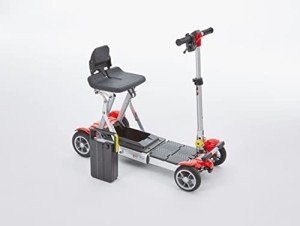Why All The Fuss About Mobility Devices?

Understanding Mobility Devices: Enhancing Independence and Quality of Life
In today's fast-paced world, the desire for mobility is universal. However, particular medical conditions or age-related difficulties can prevent movement, leading to an ongoing search for help. Mobility devices serve as necessary tools to enhance independence, enhance lifestyle, and enable individuals to engage fully in their communities. This short article provides a detailed introduction of mobility devices, including their types, features, choice criteria, and more.
Types of Mobility Devices
Mobility devices vary from easy aids to intricate devices, customized to fulfill different needs. Below is a table summarizing typical kinds of mobility devices:
| Type of Device | Description | Ideal For |
|---|---|---|
| Walkers | Four-legged assistance devices that offer exceptional stability while strolling. | Individuals needing extra assistance. |
| Canes | Single or three-legged sticks that improve balance and support walking. | Those with small mobility difficulties. |
| Wheelchairs | Seats installed on wheels, available in handbook and electric variations. | Individuals with minimal or no mobility. |
| Scooters | Electric vehicles designed for outside usage and ease of navigation. | Those who can't walk fars away. |
| Crutches | Devices that assist people move weight far from an injured leg. | People recovering from leg injuries. |
| Rollators | Walkers with wheels, seats, and brakes for improved mobility. | Users requiring rest options while walking. |
| Lift Chairs | Reclining chairs that help users in standing and taking a seat. | Seniors or those with mobility constraints. |
| Mobility Scooters | Small electric automobiles for limited mobility, frequently used outdoors. | People requiring help over fars away. |
Key Features of Mobility Devices
When picking a mobility gadget, numerous key features need to be considered to guarantee optimal performance and ease of usage:
- Weight Capacity: Understanding the gadget's weight restriction is crucial for safety and efficiency.
- Adjustability: Devices must be adjustable in height and width to fit the user comfortably.
- Mobility: Lightweight and foldable choices are necessary for users who travel or need transport.
- Stability and Safety: Look for functions like anti-tip wheels and sturdy structures to improve safety.
- Alleviate of Use: Simple systems and easy to use styles can make a substantial difference in everyday usage.
- Comfort: Ergonomic styles and cushioned seats can boost the user experience.
Choosing the Right Mobility Device
Selecting the ideal mobility device can be a complicated task. Here are some actions to guide the decision-making process:
- Assess Needs: Evaluate the individual's mobility challenges and day-to-day activities.
- Seek advice from a Professional: Engage health care professionals who can supply recommendations based upon the person's physical condition.
- Trial Options: If possible, trial various devices to identify convenience and functionality.
- Evaluation Budget: Consider the cost of the device, consisting of any additional functions or adjustments needed.
- Research study Options: Determine the very best brands and models by reading reviews and contrasts.
Table: Comparative Analysis of Popular Mobility Devices
| Gadget | Advantages | Downsides |
|---|---|---|
| Walkers | Exceptional stability, promotes walking. | Large, may restrict motion in small spaces. |
| Walking canes | Lightweight, improves balance. | May not provide enough assistance for extreme mobility issues. |
| Wheelchairs | Ideal for those with substantial mobility restrictions. | Can be troublesome, particularly in indoor environments. |
| Scooters | Great for outdoor use, easy to maneuver. | Minimal indoor functionality, much heavier. |
| Rollators | Provides rest alternative, simple to move. | May require more space than conventional walkers. |
| Raise Chairs | Comfy, helps shift from sitting to standing. | More expensive, larger footprint. |
Often Asked Questions (FAQs)
1. What is a mobility device?
A mobility gadget is any tool developed to assist individuals in moving and navigating their environment. This includes walkers, wheelchairs, scooters, and crutches.
2. How do I understand which mobility device is best for me?
Consider your specific mobility challenges, physical capabilities, and way of life requirements. Consulting with health care specialists can likewise offer customized recommendations.
3. Are mobility devices covered by insurance?
Numerous insurance plans, including Medicare, might cover certain mobility devices. It's crucial to consult your insurance provider for particular protection details.
4. Can I rent a mobility gadget instead of purchasing one?
Yes, many medical supply shops and pharmacies provide leasings for mobility devices. web is useful for people with short-term mobility concerns.
5. How can I maintain my mobility gadget?
Routine maintenance is essential. It consists of cleaning the device, inspecting for wear and tear, and ensuring all parts are working correctly.
The Impact of Mobility Devices on Quality of Life
Mobility devices substantially enhance the quality of life for people with restricted mobility. They promote independence, motivate social interaction, and enhance access to necessary services and leisure activities.
- Increased Independence: Users can browse their communities, go to events, and engage in hobbies without counting on others.
- Social Engagement: Mobility devices assist in involvement in social gatherings, thereby combating sensations of seclusion.
- Boosted Safety: Devices offer stability and minimize the threat of falls, promoting user confidence.
Mobility devices are more than simply tools for motion; they are gateways to self-reliance and quality living. By understanding the various kinds of mobility aids offered, their key features, and factors to consider for selecting the ideal device, people can make informed decisions about their mobility needs. Ultimately, the best mobility device can result in a more active, satisfying life. Whether it's a walker, wheelchair, or scooter, the right option contributes significantly to enhancing the mobility and independence of users.

